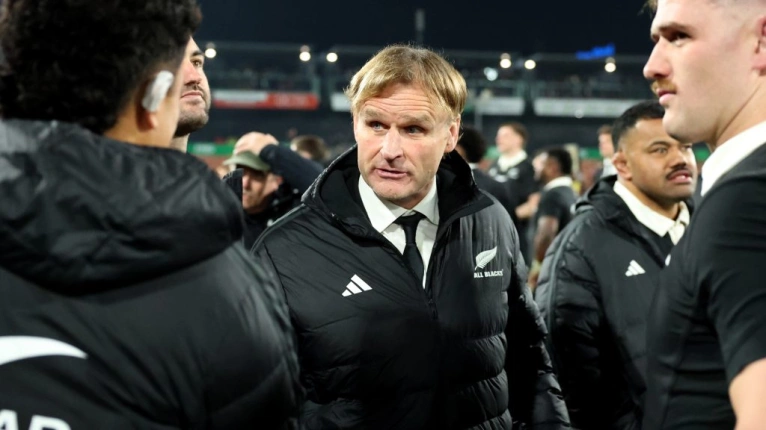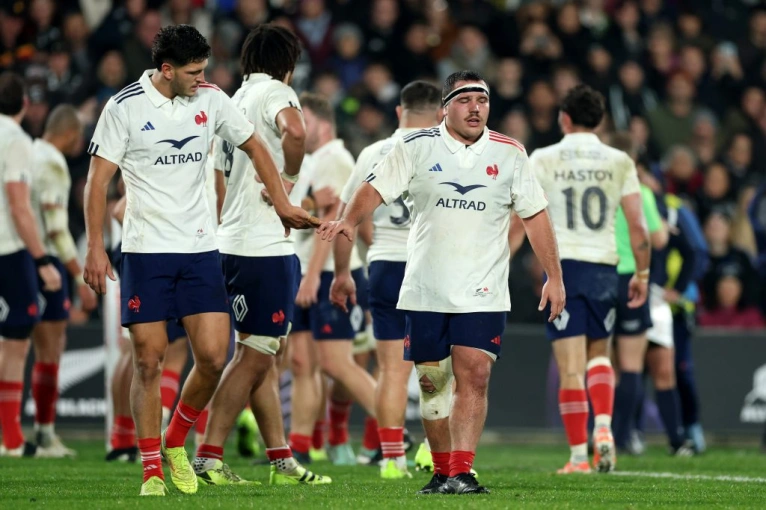In the end, it was business as usual: 3-0 to the All Blacks, France’s heavily rotated squad vanquished, with a white-coated ‘Razor’ Robertson able to make more experiments in laboratory ‘B’ as the series developed.
Ahead of the opening whistle for the third Test in Hamilton, there were only three first choice All Blacks starting the game, and two of those were not playing in the positions Razor had originally intended.

France ‘B’ were as spirited and determined as everyone anticipated, and as cussed in defence and at the breakdown as you would expect from any typical Top 14 selection, but by the end it was a second division game, and my original prediction for the series had been fully justified:
“There is little doubt the French ‘B’ team will provide a more-than-useful workout for the All Blacks. The size of their forwards and use of a 6/2 bench will give New Zealand an important presentiment of the Springboks at the Rugby Championship.
“But make no mistake, it will be test with a small ‘t’, rather than the full-blooded Test series between the crowned heads of European rugby and the mighty All Blacks it should rightly have been. It could have been one of the great ones.”
The galling irony from a Gallic perspective is this series was so eminently winnable for the visitors. Just a sprinkling of say, half a dozen of their top ‘A’ teamers would have been enough to swing the odds in their favour. In terms of operating within the given ‘player welfare’ criteria, there was precious little difference between the 23 that finished the Six Nations and the squad which entered the lists versus New Zealand at Hamilton.

Twenty-one of the players who featured in the final round of the Six Nations against Scotland eventually surpassed the magical 2000 minute/25 game limit highlighted by Fabien Galthié over the entire 2024-25 season. Only four of the 23-man squad at the Waikato Stadium still fell within Galthié’s parameters, and two of those [front rowers Pierre Bourgarit and Demba Bamba] had been injured for large swathes of the Top 14 season. Eight were involved in 30 matches or more, and two – Racing 92’s estimable Nolann Le Garrec [34 games and 2088 minutes] and Gaël Fickou [30 and 2018 minutes] – finished well across both red lines.
Imagine the difference a veteran Toulousain front-row of Cyrille Baille, Julien Marchand and Dorian Aldegheri might have made off the pine for a mere 30 minutes. One of the best loose-head props in the world, Baille, only had 18 game involvements and 635 minutes on the clock, so he might have appreciated the opportunity to be involved rather more than he was. At 31 years of age, Baille will never get another chance to visit the land of the long white cloud again – at least, not near the peak of his very considerable playing powers.
Without that trio, the French scrum effort crumbled and the All Blacks grabbed the struggle for territory by the throat.
Les Bleus should be applauded for trading blow for blow in four of the six halves of footy, despite the constant ‘musical chairs’ of squad rotation between games. “They’ve been going for about 11 months, those guys, and they could have rolled over. But it’s not their way” as Robertson put it after the game.
But the skull beneath the skin is Galthié’s capacity to build from the foundations of one Test to the next was stripped back to less than nothing. It is no coincidence the first three names inked on to a shortlist of July success stories from the tour would be those of Theo Attissogbe, Le Garrec and Mickaël Guillard. All three will return to Europe with their reputations enhanced after showcasing world-class potential. But they were also the only French players to start in all three Tests. Go figure.
Robertson and his coaches will have learned far more from the experience simply through their process of selection. Instead of starting from scratch in every Test, Robertson was able to feed new blood into a core group of established players. He was able to link old and new, veteran to rookie in his combinations and the All Blacks were all the better for it. That is what evolution means.
Now we know Fabian Holland can be a live part of the All Black second row debate in the Rugby Championship and beyond, while Tupou Vaa’i provides a realistic option at number six. Christian Lio-Willie looks like a reliable back-up to Wallace Sititi at eight, and Robertson has the choice of picking the back-row two ways. He can go heavy with someone like Vaa’i at 6 and Ardie Savea at 7, or he can go full England and unleash the ‘light brigade’ with three sevens [Du Plessis Kirifi, Dalton Papali’i with Savea at eight] on the field at the same time.
In the backline there have been two more important discoveries. Ruben Love did not put a foot wrong on debut at full-back while Noah Hotham added a spark when he entered the fray in the last 15 minutes. Speaking to Sky Sport in the aftermath, Razor name-checked Hotham as the player who added tactical value from the bench:
“Those [new] guys are going to be better for the experience… playing from behind for the majority of the Test match [we] found out a lot about ourselves – so they’ll be better for that.
“[France] played 14 in the front and a really shallow full-back, and we didn’t really expose it enough until the end. Noah [Hotham] came on and he’s a plucky little half-back. He made some great little kicks, and even Will Jordan’s try put us away. We could have probably tactically been better.”
What did Razor really mean by those comments? When I was preparing for the England tour of New Zealand back in 2014, one of the highlights which impressed me the most was the tactical transition New Zealand made between the first and second Tests against France the previous year. In the first game at Eden Park, Les Bleus came as close to overturning the odds as they did 12 years later. The match was nail-bitingly close entering the final quarter and the hosts were under pressure from France’s relentless efforts at the breakdown, which resulted in a stream of turnover ball.
Although New Zealand eventually won 23-13, they made sure they learned their lesson for the second match in Christchurch. Instead of trying to keep the ball in hand on principle, New Zealand kicked the ball 40 times while only building 44 rucks in the game. They gave the French defence no targets to hit and exploited the space in behind, and they won the game decisively, by 30-0.
The redoubtable Shaun Edwards is France’s current defence coach and the 14-man line is his signature thumbprint. Where most D coaches will only use a 14-man line in situations close to the goal-line, Edwards is often happy to employ it anywhere up to halfway if he is convinced the opposition do not have the ability to exploit the lone defender of the backfield with their kicking game.
New Zealand only kicked 25 times while building 170 rucks in Hamilton, and as Razor observed, they could have used the kicking game more often, and been tactically better than they were when consistently presented with this defensive picture.

The French full-back Leo Barré is patrolling both sides of the pitch only 5-10m behind a front line of 14 defenders, so it makes sense to attack the areas to either side of him. In the first half, there a couple of near misses from the boots of Jordan and Damian McKenzie sandwiching an excellent spot by scrum-half Cortez Ratima.
Barré is a big man at over 6ft 2ins and 90kg, so why not examine his range of lateral movement and pull him from one side of the field to the other? The tactical picture only changed around the hour mark with a chip through by D-Mac, and Hotham’s very promising 15-minute cameo.
New Zealand already has two top-drawer, left-sided number nines in the form of Ratima and Cam Roigard, but that ability to change the tactical picture hinted at a gold ‘nugget’ rugby IQ. Hotham may just be about to add a point of difference the All Blacks have lacked since Aaron Smith’s retirement.
Player welfare or no player welfare, France will probably be kicking themselves for blowing a real opportunity to beat the All Blacks on their own turf. A small dusting of experience and veteran leadership in key areas of the team might have been enough for them to come away with a colossal, confidence-building series victory at the other end of the Earth.
In terms of team development, the constant chopping and changing of the team meant Galthié left New Zealand shores with a pauper’s portion instead of the abundant feast which was so clearly on offer.
In the event, the meal was never as satisfying as the rugby calendar promised it could be, but it is New Zealand who have eaten most heartily and picked the bones from the table. Robertson has unearthed some options in the back-five forwards, a new star in the back three and a sharp tactical brain in between them. The tour has served his needs and promoted some evolution in his All Blacks. For France, it has shifted interest further away from the international game, and avouched national allegiance to that ever-growing hub of global club rugby, the Top 14. France has sworn its oath: Vive la Dévolution!


And true!